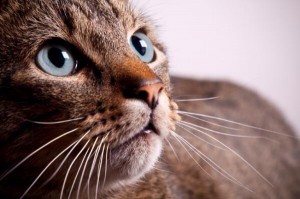News
Archive for October, 2018
Feline leukaemia virus (FeLV) and Feline immunodeficiency virus (FIV)
by admin on October 1st, 2018
Category: News, Tags:
What are FeLV and FIV?
Feline leukaemia virus (FeLV) and feline immunodeficiency virus (FIV) both belong to the same group of viruses, the retrovirus group. This means they are somewhat related to one another and act in a similar way. Retroviruses such as FeLV and FIV are particularly successful because the immune system usually fails to remove them completely (unlike many other viruses), so affected cats become infected for life. Feline immunodeficiency virus (FIV) is related to the human immunodeficiency virus (HIV), but humans and cats cannot infect each other with their respective viruses.
How do cats get FeLV or FIV?
Cats can get FeLV and FIV through contact with other cats.
Feline leukaemia virus is usually transmitted through saliva, most commonly by friendly, social cats who like mutual grooming and do not mind sharing food bowls. However, FeLV can also be transmitted through bites.
Feline immunodeficiency virus is usually transmitted through biting by an infected cat, so individuals with FIV are typically entire tom cats or any other cats that like fighting.
What are the clinical signs of FeLV and FIV?
Both FeLV and FIV cause similar problems by gradually weakening the immune system. The protection this system normally gives against invading bacteria, viruses, fungi or parasites functions less and less well, and infected cats become prone to infections that a healthy immune system would often just fight off. As the immune system also helps to protect the body against cancer, infected cats in advanced stages of the disease have a much higher chance of developing a cancerous disease. Anaemia is another common problem, particularly in cats with FeLV. Despite its name, feline leukaemia virus does not necessarily cause leukaemia – it can do so, but it also causes a multitude of other diseases.
When an infected cat becomes ill, the clinical signs seen are usually due to the secondary infection or the cancerous disease which develops, rather than the underlying FeLV or FIV infection. This means that there are no typical clinical signs for either disease. Vets usually become suspicious when cats are presented either with persisting infections which they should be able to fight off, or with ‘non-standard’ disease, or with several concurrent infectious problems, or if the response to treatment is not as expected.
How and when is the disease diagnosed?
There are two possible situations in which tests are carried out for either FeLV or FIV.
- FeLV or FIV is suspected as an underlying disease
- A healthy cat is tested for FeLV and FIV to ensure that he or she is not carrying the virus already. This may be advisable before a newly adopted cat is introduced into the household, before breeding is attempted or before the first FeLV vaccination is given.
Whatever the reason for testing a particular cat, it is usually possible to diagnose FeLV and FIV with a blood test that can be done at the surgery. However, in some cases we may suggest sending a blood sample to a laboratory for more advanced testing methods to be used.
Can FeLV or FIV be treated?
Cats carrying FeLV and FIV virus cannot be cured. Both viruses cannot be destroyed by medication – this is similar to the situation in people with HIV. In human medicine, advanced anti-viral drugs are now available – these can effectively suppress the activity of the virus for long periods of time. Few of these (very costly) drugs have been used in cats and it is not really known whether such drugs are effective for FeLV/FIV or safe for cats to take. This means that there is currently no recommended specific treatment against either FeLV or FIV.
As the majority of clinical signs caused by both FeLV and FIV are due to a non-functioning immune system, it is often possible to treat any secondary infections or problems, thereby giving the patient a reasonable quality of life for a longer period of time. However, it must be remembered that the infected individual is a danger to the rest of the cat population and will spread FeLV or FIV unless he or she is kept isolated from other cats.
Can FeLV or FIV be prevented?
Whilst FeLV cannot be treated once a cat carries the disease, it is possible to prevent infection by vaccination. FeLV vaccination is advisable for all cats that can go out or have contact with cats that go out. Only cats that are kept indoors and have no contact with other cats do not need FeLV vaccination.
Unfortunately there is no FIV vaccine which is licensed for use in the UK, so prevention is much more difficult than it is for FeLV. Any cat that is not kept indoors at all times is at risk of infection with FIV.
My cat has tested positive for FeLV or FIV – what is the outlook?
This can depend very much on why your cat has been tested. If he or she was tested because of severe or recurrent illness and is positive for one or both diseases, this means that the disease is already present and the immune system is already compromised. Under these circumstances unfortunately the outlook may be poor. It may be possible to give your cat a reasonable quality of life for a period of time with medication and very good care. However, he or she will be shedding the virus and will therefore be a danger to other cats. If other cats live in the family, they should certainly be tested – even if they appear healthy – in order to find out whether they are already carrying the virus.
If your FeLV or FIV positive cat is otherwise healthy and was tested as a routine precaution, then the outlook depends very much on the particular circumstances. Depending on the individual animal, it may take months or even many years before the disease breaks out and the cat will seem healthy in the meantime. However, he or she will be able to pass on the virus to other cats. This means that your cat should be kept indoors and away from other cats. It is also advisable to ensure good health through regular vaccinations and worming, very good nutrition and dental care.
While some cats are happy to stay indoors and away from other cats – especially if someone in the family is at home at all times, too – others will not like being so confined, especially if they are used to an outdoor life. Should such a situation arise, we will discuss the options with you in detail and should you feel that you are able to give your cat a good quality of life we will also discuss special health-care issues to keep your cat happy and comfortable for as long as possible.
Special offer – October 2018
by admin on October 1st, 2018
Category: Special Offers, Tags:
Pet of the month – October – Niamh
by admin on October 1st, 2018
Category: Pet of the Month, Tags:
Blood tests showed Niamh to have developed renal failure and because of the unique and unusual nature of the presentation she was referred to a specialist. Further diagnostic work indicated ‘acute on chronic’ kidney disease – very unusual in a five year old dog, as she was then.
Niamh has been the sweetest of patients with an extremely friendly, upbeat nature even when has been feeling very ill; despite the gravity of her illness she made great progress and was in remission until earlier this year when she started to deteriorate again. With appropriate treatment Niamh’s blood results have improved and we are hoping she may be back in remission again very soon.




